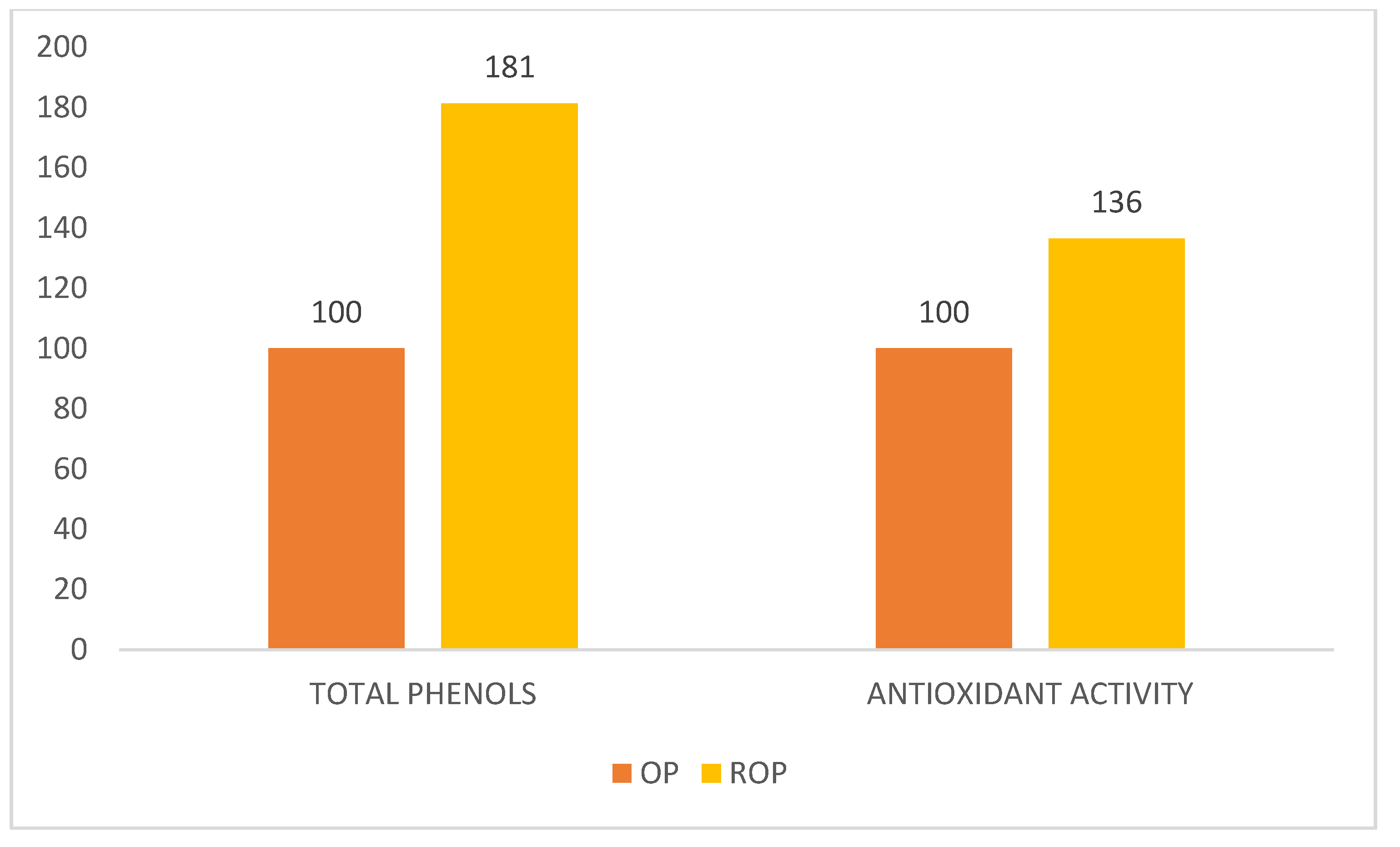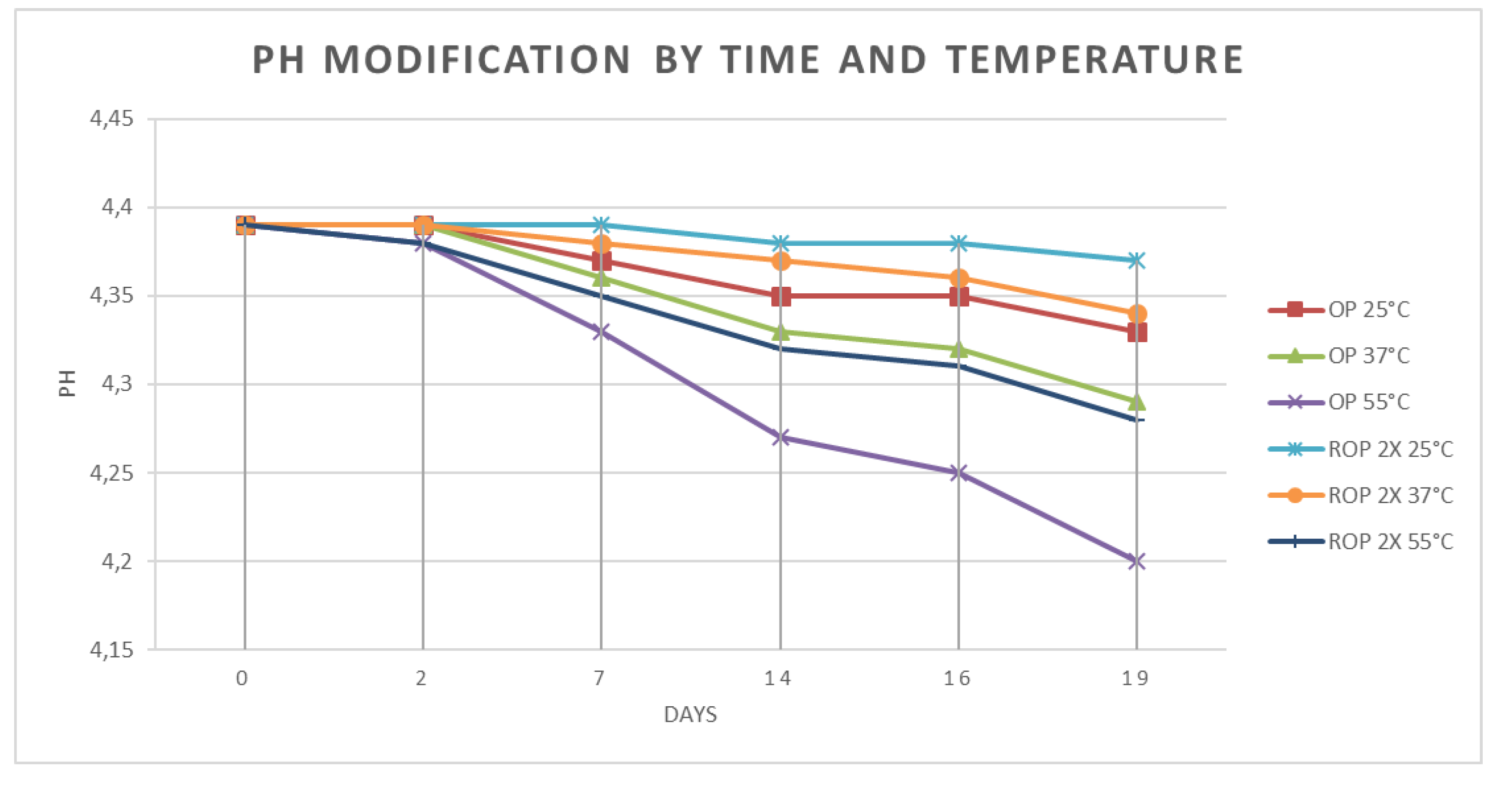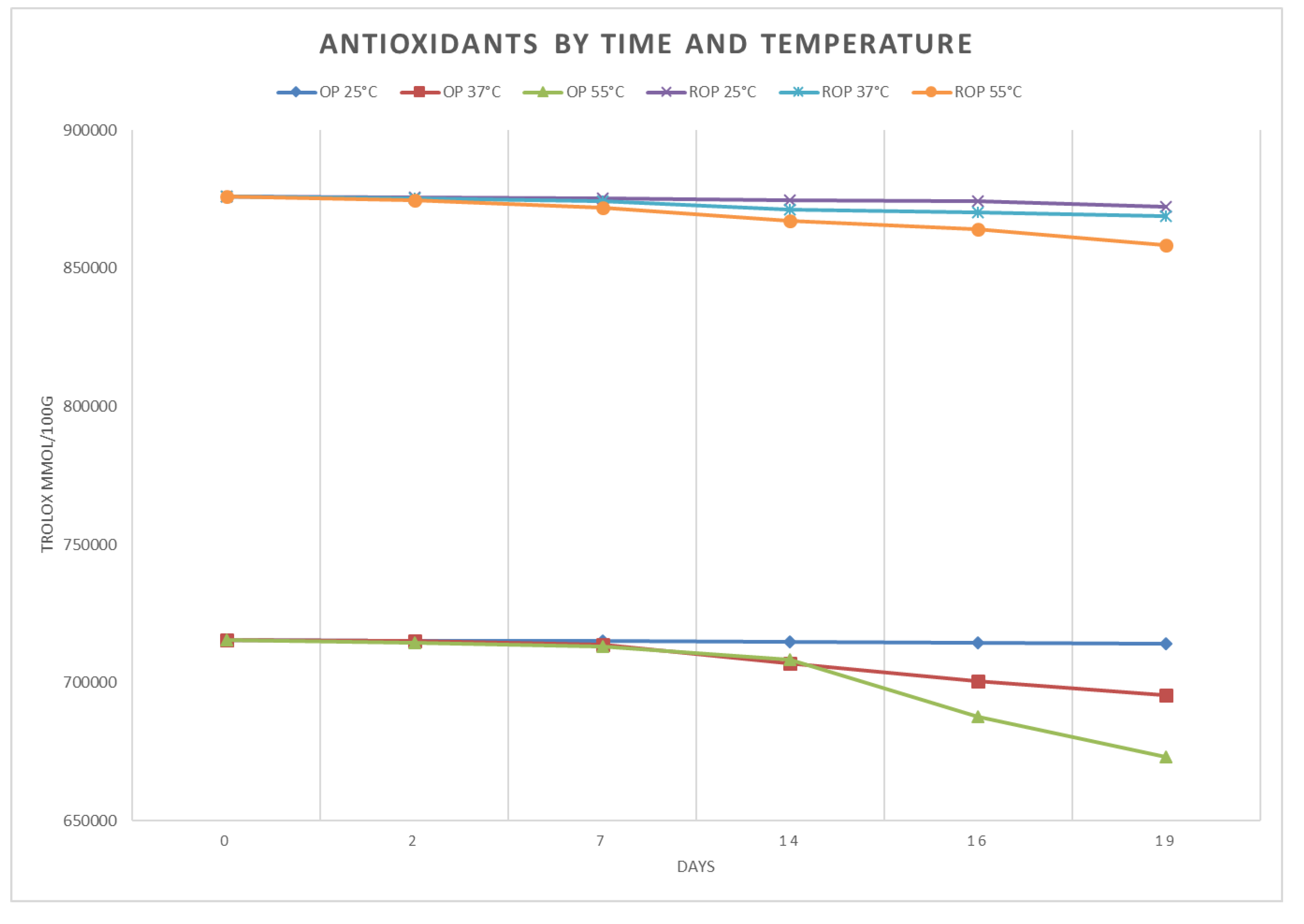An Innovative Olive Pâté with Nutraceutical Properties
Abstract
1. Introduction
2. Materials and Methods
2.1. OP and ROP Preparation
2.2. Pasteurization Process
2.3. Chemicals
2.4. Total Phenolic Compounds
2.5. Antioxidant Activity Determination
2.6. UHPLC Operative Condition
2.7. Orbitrap UHPLC-MS/MS Operative Condition
2.8. Shelf-Life Analysis
2.8.1. Microbiological Analysis
2.8.2. pH and Water Activity
2.8.3. Stress Test and Pasteurization Effects
2.9. Palatability Test
2.10. Statistical Analysis
3. Results
3.1. Phenolic Profile and Concentrations
3.2. Other Analytical Results
4. Discussion
5. Conclusions
Supplementary Materials
Author Contributions
Funding
Conflicts of Interest
References
- Hu, F.B. The Mediterranean diet and mortality-olive oil and beyond. N. Engl. J. Med. 2003, 348, 2595–2596. [Google Scholar] [CrossRef]
- Owen, R.W.; Giacosa, A.; Hull, W.E.; Haubner, R.; Würtele, G.; Spiegelhalder, B.; Bartsch, H. Olive-oil consumption and health: The possible role of antioxidants. Lancet Oncol. 2000, 1, 107–112. [Google Scholar] [CrossRef]
- De Marco, E.; Savarese, M.; Paduano, A.; Sacchi, R. Characterization and fractionation of phenolic compounds extracted from olive oil mill wastewaters. Food Chem. 2007, 104, 858–867. [Google Scholar] [CrossRef]
- Araújo, M.; Pimentel, F.B.; Alves, R.C.; Oliveira, M.B.P.P. Phenolic compounds from olive mill wastes: Health effects, analytical approach and application as food antioxidants. Trends Food Sci. Technol. 2015, 45, 200–211. [Google Scholar] [CrossRef]
- Rahmanian, N.; Jafari, S.M.; Galanakis, C.M. Recovery and Removal of Phenolic Compounds from Olive Mill Wastewater. J. Am. Oil Chem. Soc. 2014, 91, 1–18. [Google Scholar] [CrossRef]
- Takac, S.; Karakaya, A. Recovery of Phenolic Antioxidants from Olive Mill Wastewater. Recent Pat. Chem. Eng. 2009, 2, 230–237. [Google Scholar] [CrossRef]
- Allouche, N.; Fki, I.; Sayadi, S. Toward a High Yield Recovery of Antioxidants and Purified Hydroxytyrosol from Olive Mill Wastewaters. J. Agric. Food Chem. 2004, 52, 267–273. [Google Scholar] [CrossRef]
- Roselló-Soto, E.; Parniakov, O.; Deng, Q.; Patras, A.; Koubaa, M.; Grimi, N.; Boussetta, N.; Tiwari, B.K.; Vorobiev, E.; Lebovka, N.; et al. Application of Non-conventional Extraction Methods: Toward a Sustainable and Green Production of Valuable Compounds from Mushrooms. Food Eng. Rev. 2016, 8, 214–234. [Google Scholar] [CrossRef]
- Pokorný, J. Natural antioxidants for food use. Trends Food Sci. Technol. 1991, 2, 223–227. [Google Scholar] [CrossRef]
- Dewanto, V.; Wu, X.; Adom, K.K.; Liu, R.H. Thermal Processing Enhances the Nutritional Value of Tomatoes by Increasing Total Antioxidant Activity. J. Agricand Food Chem. 2002, 50, 3010–3014. [Google Scholar] [CrossRef]
- Carlsen, M.H.; Halvorsen, B.L.; Holte, K.; Bøhn, S.K.; Dragland, S.; Sampson, L.; Willey, C.; Senoo, H.; Umezono, Y.; Sanada, C.; et al. The total antioxidant content of more than 3100 foods, beverages, spices, herbs and supplements used worldwide. Nutr. J. 2010, 9, 3. [Google Scholar] [CrossRef] [PubMed]
- Savarese, M.; De Marco, E.; Falco, S.; D’Antuoni, I.; Sacchi, R. Biophenol extracts from olive oil mill wastewaters by membrane separation and adsorption resin. Int. J. Food Sci. Technol. 2016, 51, 2386–2395. [Google Scholar] [CrossRef]
- Vissers, M.N.; Zock, P.L.; Roodenburg, A.J.C.; Leenen, R.; Katan, M.B. Olive Oil Phenols Are Absorbed in Humans. Nutr. J. 2002, 132, 409–417. [Google Scholar] [CrossRef]
- Visioli, F.; Galli, C.; Bornet, F.; Mattei, A.; Patelli, R.; Galli, G.; Caruso, D. Olive oil phenolics are dose-dependently absorbed in humans. FEBS Lett. 2000, 468, 159–160. [Google Scholar] [CrossRef]
- Cosmai, L.; Caponio, F.; Summo, C.; Paradiso, V.M.; Cassone, A.; Pasqualone, A. New formulations of olive-based patè: Development and quality. Ital. J. Food Sci. 2017, 29, 302–316. [Google Scholar] [CrossRef]
- Alvarenga, N.B.; Lidon, F.J.C.; Silva, A.; Martins, G.; Cruz, T.; Palma, V.; Canada, J. Production and characterization of green and black olive paste using cream of animal and vegetable origins. Emir. J. Food Agric. 2012, 24, 12–16. [Google Scholar] [CrossRef]
- Cosmai, L.; Campanella, D.; De Angelis, M.; Summo, C.; Paradiso, V.M.; Pasqualone, A.; Caponio, F. Use of starter cultures for table olives fermentation as possibility to improve the quality of thermally stabilized olive-based paste. LWT 2018, 90, 381–388. [Google Scholar] [CrossRef]
- Nieto, A.; Grande Burgos, M.J.; GÁLvez, A.; Pérez Pulido, R. Preservation of Paste Obtained from Picual Green Olives by High Hydrostatic Pressure Treatment. Czech J. Food Sci. 2017, 35, 246–250. [Google Scholar] [CrossRef]
- Aka-Kayguluoglu, A.; Akpinar-Bayizit, A.; Sahin-Cebeci, O.I. Evaluation of physicochemical and sensory properties of green olive pastes. Indian J. Tradit. Knowl. 2014, 13, 654–658. [Google Scholar]
- Cosmai, L.; Campanella, D.; Summo, C.; Paradiso, V.M.; Pasqualone, A.; De Angelis, M.; Caponio, F. Shelf life of stored not pasteurized olive-based pâtés. Ital. J. Food Sci. 2015, 28, 28–32. [Google Scholar]
- Escudero-Gilete, M.L.; Meléndez-Martínez, A.J.; Heredia, F.J.; Vicario, I.M. Optimization of olive-fruit paste production using a methodological proposal based on a sensory and objective color analysis. Grasas Y Aceites 2009, 60, 396–404. [Google Scholar]
- Singleton, V.L.; Rossi, J.A. Colorimetry of total phenolics with phosphmolybdic phospotungstic acid reagents. Am. J. Enol. Vitic. 1965, 16, 144–158. [Google Scholar]
- Montedoro, G.F.; Cantarelli, C. Investigation on the Phenolic Compounds of Virgin Olive Oils. Riv. Ital. Sostanze Grasse 1969, 46, 115–124. [Google Scholar]
- Vazquez-Roncero, A. A Study of the Polar Compounds in Olive Oil by Gas Chromatography. Grasas Y Aceites 1980, 31, 309–316. [Google Scholar]
- Solinas, M.; Cichelli, A. Determination of Phenolic Substances in Olive Oil by GLC and HPLC; Possible Role of Tyrosol in Determination of the Quantity of Virgin Oil in Blends with Refined Oil. Riv. Soc. Ital. Sci. Aliment. 1982, 11, 223–230. [Google Scholar]
- Sudjana, A.N.; D’Orazio, C.; Ryan, V.; Rasool, N.; Ng, J.; Islam, T.; Riley, V.; Hammera, K.A. Antimicrobial activity of commercial Olea europaea (olive) leaf extract. Int. J. Antimicrob. Agents 2009, 33, 461–463. [Google Scholar] [CrossRef] [PubMed]
- Obied, H.K.; Allen, M.S.; Bedgood, D.R.; Prenzler, P.D.; Robards, K.; Stockmann, R. Bioactivity and analysis of biophenols recovered from olive mill waste. J. Agric. Food Chem. 2005, 53, 823–837. [Google Scholar] [CrossRef] [PubMed]
- Servili, M.; Baldioli, M.; Selvaggini, R.; Miniati, E.; Macchioni, A.; Montedoro, G. High-performance liquid chromatography evaluation of phenols in olive fruit, virgin olive oil, vegetation waters, and pmace and 1D-and 2D-nuclear magnetic resonance characterization. J. Am. Oil Chem. Soc. 1999, 76, 873–882. [Google Scholar] [CrossRef]
- Re, R.; Pellegrini, N.; Proteggente, A.; Pannala, A.; Yang, M.; Rice-Evans, C. Antioxidant activity applying an improved ABTS radical cation decolorization assay. Free Radic. Biol. Med. 1999, 26, 231–1237. [Google Scholar] [CrossRef]
- AOAC. Appendix F: Guidelines for Standard Method Performance Requirements (SMPR). In AOAC Official Methods of Analysis; AOAC INTERNATIONAL: Gaithersburg, MD, USA, 2012. [Google Scholar]
- Dini, I.; Graziani, G.; Fedele, F.L.; Sicari, A.; Vinale, F.; Castaldo, L.; Ritieni, A. Effects of Trichoderma biostimulation on the phenolic profile of extra-virgin olive oil and olive oil by-products. Antioxidants 2020, 9, 284. [Google Scholar] [CrossRef]
- Dini, I.; Graziani, G.; Gaspari, A.; Fedele, F.L.; Sicari, A.; Vinale, F.; Cavallo, P.; Lorito, M.; Ritieni, A. New Strategies in the Cultivation of Olive Trees and Repercussions on the Nutritional Value of the Extra Virgin Olive Oil. Molecules 2020, 25, 2345. [Google Scholar] [CrossRef] [PubMed]
- Vita, J.A. Polyphenols and cardiovascular disease: Effects on endothelial and platelet function. Am. J. Clin. Nutr. 2005, 81, 292S–297S. [Google Scholar] [CrossRef] [PubMed]
- Stoclet, J.C.; Chataigneau, T.; Ndiaye, M.; Oak, M.H.; El Bedoui, J.; Chataigneau, M.; Shini-Kerth, V.B. Vascular protection by dietary polyphenols. Eur. J. Pharm. 2004, 500, 299–313. [Google Scholar] [CrossRef] [PubMed]
- Montesano, D.; Rocchetti, G.; Cossignani, L.; Senizza, B.; Pollini, L.; Lucini, L.; Blasi, F. Untargeted Metabolomics to Evaluate the Stability of Extra-Virgin Olive Oil with Added Lycium barbarum Carotenoids during Storage. Foods 2019, 8, 179. [Google Scholar] [CrossRef]
- Lozano-Sánchez, J.; Bendini, A.; Di Lecce, G.; Valli, E.; Toschi, T.G.; Segura-Carretero, A. Macro and micro functional components of a spreadable olive by-product (pâté) generated by new concept of two-phase decanter. Eur. J. Lipid Sci. Technol. 2016, 119, 1600096. [Google Scholar] [CrossRef]
- Gil-Chávez, J.G.; Villa, J.A.; Ayala-Zavala, F.J.; Heredia, B.J.; Sepulveda, D.; Yahia, E.M.; González-Aguilar, G.A. Technologies for extraction and production of bioactive compounds to be used as nutraceuticals and food ingredients: An overview. Compr. Rev. Food Sci. Food Saf. 2013, 12, 5–23. [Google Scholar] [CrossRef]
- Dini, I.; Laneri, S. Nutricosmetics: A brief overview. Phytother. Res. 2019, 33, 3054–3063. [Google Scholar] [CrossRef]
- Ruzzolini, J.; Peppicelli, S.; Andreucci, E.; Bianchini, F.; Scardigli, A.; Romani, A.; La Marca, G.; Nediani, C.; Calorini, L. Oleuropein, the Main Polyphenol of Olea europaea Leaf Extract, Has an Anti-Cancer Effect on Human BRAF Melanoma Cells and Potentiates the Cytotoxicity of Current Chemotherapies. Nutrients 2018, 10, 1950. [Google Scholar] [CrossRef]
- Allen, L.H.; De Benoist, B.; Dary, O.; Hurrell, R. World Health Organization. Guidelines on Food Fortification with Micronutrients; World Health Organisation: Geneva, Switzerland, 2006; pp. 1–341. [Google Scholar]
- Artajo, L.S.; Romero, M.P.; Morelló, J.R.; Motilva, M.J. Enrichment of Refined Olive Oil with Phenolic Compounds: Evaluation of Their Antioxidant Activity and Their Effect on the Bitter Index. J. Agric. Food Chem. 2006, 54, 6079–6088. [Google Scholar] [CrossRef]
- Schaich, K.M.; Tian, X.; Xie, J. Hurdles and pitfalls in measuring antioxidant efficacy: A critical evaluation of ABTS, DPPH, and ORAC assays. J. Funct. Foods 2015, 14, 111–125. [Google Scholar] [CrossRef]
- Morris, V.L.; Toseef, T.; Nazumudeen, F.B.; Rivoira, C.; Spatafora, C.; Tringali, C.; Rotenberg, S.A. Anti-tumor properties of cis-resveratrol methylated analogs in metastatic mouse melanoma cells. Mol. Cell Biochem. 2015, 402, 83–91. [Google Scholar] [CrossRef] [PubMed]
- Weiskirchen, S.; Weiskirchen, R. Resveratrol: How much wine do you have to drink to stay healthy? Adv. Nutr. 2016, 7, 706–718. [Google Scholar] [CrossRef] [PubMed]
- Jeandet, P.; Bessis, R.; Maume, B.F.; Sbaghi, M. Analysis of resveratrol in burgundy wines. J. Wine Res. 1993, 4, 79–85. [Google Scholar] [CrossRef]
- Marković, A.K.; Torić, J.; Barbarić, M.; Brala, C.J.; Paiva-Martins, F. Hydroxytyrosol, Tyrosol and Derivatives and Their Potential Effects on Human Health. Molecules 2019, 24, 2001. [Google Scholar] [CrossRef]
- Plazl, I.; Lakner, M.; Koloini, T. Modeling of temperature distributions in canned tomato based dip during industrial pasteurization. J. Food Eng. 2006, 75, 400–406. [Google Scholar] [CrossRef]
- Boor, K.J. Fluid dairy product quality and safety: Looking to the future. J. Dairy Sci. 2001, 84, 1. [Google Scholar] [CrossRef]
- Delaquis, P.J.; Stewart, S.; Toivonen, P.M.A.; Moyls, A.L. Effect of warm, chlorinated water on the microbial flora of shredded iceberg lettuce. Food Res Int. 1999, 32, 7–14. [Google Scholar] [CrossRef]
- Oliveira, A.; Pintado, M.; Almeida, D.P.F. Phytochemical composition and antioxidant activity of peach as affected by pasteurization and storage duration. LWT-Food Sci. Technol. 2012, 49, 202–207. [Google Scholar] [CrossRef]
- Salta, F.N.; Mylona, A.; Chiou, A.; Boskou, G.; Andrikopoulos, N.K. Oxidative Stability of Edible Vegetable Oils Enriched in Polyphenols with Olive Leaf Extract. Food Sci. Technol. Int. 2007, 13, 413–421. [Google Scholar] [CrossRef]





| Minutes | Phase B% 100% Acetonitrile(ACN) | Phase A% H2O Containing 0.1% (v/v) Acetic Acid (AcH) |
|---|---|---|
| 0–5 | 5 | 95 |
| 6–25 | 40 | 60 |
| 25.1–27 | 100 | 0 |
| 27.1–35 | 5 | 95 |
| 35.1–45 | 0 | 100 |
| Ion Source Parameters | |
|---|---|
| Spray Voltage | −3.0 kV |
| Sheath gas | (N2 > 95%) 30 |
| Auxiliary gas | (N2 > 95%) 15 |
| Capillary temperature | 200 °C |
| S-lens | RF level 50 |
| Auxiliary gas | 305 °C |
| Analyzer Target SIM (Single Ion Monitoring) Parameter | |
| Automatic gain control (AGC) | target set at 1 and 6 |
| Resolution | 140,000 FWHM (full width at half maximum) |
| Scan rate | (100–500 m/z) |
| Group | Compound | OP (mg/kg) | ROP (mg/kg) | Delta | Delta% of Baseline |
|---|---|---|---|---|---|
| Flavinoids | trans-Resveratrol | 278.1 ± 2.0 | 404.4 ± 10.2 | 126.2 | 45.4% |
| Luteolin | 9.9 ± 0.09 | 20.6 ± 0.1 | 10.7 | 107.8% | |
| Apigenin | 0.5 ± 0.0 | 0.9 ± 0.0 | 0.45 | 96.4% | |
| Secoiridoids | Ligstroside | 0.2 ± 0.004 | 0.2 ± 0.004 | 0.038 | 20.5% |
| Secologanoside | 1.6 ± 0.016 | 1.9 ± 0.019 | 0.251 | 15.4% | |
| Verbascoside | 0.6 ± 0.002 | 0.8 ± 0.009 | 0.186 | 31.1% | |
| Isoverbascoside | 0.2 ± 0.004 | 0.4 ± 0.003 | 0.139 | 55.8% | |
| Oleuropein-aglycone monoaldehyde | 0.5± 0.008 | 0.7 ± 0.011 | 0.156 | 30.6% | |
| Ligstroside-aglycone monoaldehyde | 0.3 ± 0.026 | 1.2 ± 0.031 | 0.88 | 269.9% | |
| Oleuropein | 0.4 ± 0.010 | 0.4 ± 0.002 | 0.042 | 10.2% | |
| Phenolic Alcohol | Tyrosol | 120.8 ± 6.6 | 204.5 ± 5.9 | 83.6 | 69.3% |
| OH-Tyrosol | 141.7± 3.1 | 201.1 ± 4.01 | 59.4 | 42.0% | |
| Phenolic Acids | P-Coumaric | 1.1 ± 0.014 | 0.5 ± 0.011 | −0.619 | −56.1% |
| Cyinnamic | 0.5 ± 0.017 | 0.01 ± 0.057 | −0.522 | −98.9% | |
| Ferulic | 0.3 ± 0.002 | 0.06 ± 0.001 | −0.25 | −81.4% | |
| Vanillic | 21.8 ± 0.055 | 9.0 ± 0.077 | −12.7 | −58.8% | |
| 4-Hydroxybenzoic acid | 1.0 ± 0.002 | 0.4 ± 0.007 | −0.555 | −57.8% | |
| 3-Hydroxybenzoic acid | 4.5 ± 0.061 | 2.8 ± 0.064 | −1.66 | −36.9% |
| Parameter | Pasteurization Combinations | |||
|---|---|---|---|---|
| Raw | 86 °C/20′ | 90 °C/15′ | 94 °C/10′ | |
| OP-TROLOX µmol/100 g | 715.31 | 455.308 | 515.308 | 435.308 |
| ROP-TROLOX µmol/100 g | 875.951 | 620.286 | 685.286 | 597.286 |
| OP-Gallic Acid mg/L | 2620 | 1820 | 1340 | 1520 |
| ROP-Gallic Acid mg/L | 4750 | 3550 | 2700 | 2850 |
| OP-Index for TROLOX (Raw = 100) | 100 | 63.7 | 72.1 | 60.9 |
| ROP-Index for TROLOX (Raw = 100) | 100 | 70.8 | 78.2 | 68.2 |
| OP-Index for Gallic Acid (Raw = 100) | 100 | 69.5 | 51.1 | 58.0 |
| ROP-Index for Gallic Acid (Raw = 100) | 100 | 74.7 | 56.8 | 60.0 |
© 2020 by the authors. Licensee MDPI, Basel, Switzerland. This article is an open access article distributed under the terms and conditions of the Creative Commons Attribution (CC BY) license (http://creativecommons.org/licenses/by/4.0/).
Share and Cite
Cavallo, P.; Dini, I.; Sepe, I.; Galasso, G.; Fedele, F.L.; Sicari, A.; Bolletti Censi, S.; Gaspari, A.; Ritieni, A.; Lorito, M.; et al. An Innovative Olive Pâté with Nutraceutical Properties. Antioxidants 2020, 9, 581. https://doi.org/10.3390/antiox9070581
Cavallo P, Dini I, Sepe I, Galasso G, Fedele FL, Sicari A, Bolletti Censi S, Gaspari A, Ritieni A, Lorito M, et al. An Innovative Olive Pâté with Nutraceutical Properties. Antioxidants. 2020; 9(7):581. https://doi.org/10.3390/antiox9070581
Chicago/Turabian StyleCavallo, Pierpaolo, Irene Dini, Immacolata Sepe, Gennaro Galasso, Francesca Luisa Fedele, Andrea Sicari, Sergio Bolletti Censi, Anna Gaspari, Alberto Ritieni, Matteo Lorito, and et al. 2020. "An Innovative Olive Pâté with Nutraceutical Properties" Antioxidants 9, no. 7: 581. https://doi.org/10.3390/antiox9070581
APA StyleCavallo, P., Dini, I., Sepe, I., Galasso, G., Fedele, F. L., Sicari, A., Bolletti Censi, S., Gaspari, A., Ritieni, A., Lorito, M., & Vinale, F. (2020). An Innovative Olive Pâté with Nutraceutical Properties. Antioxidants, 9(7), 581. https://doi.org/10.3390/antiox9070581










